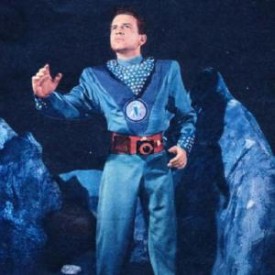
Space cadets: Obama, Perot to mine asteroids?
Aaron Klein
Google, Microsoft figures also back scheme to ‘help ensure humanity's prosperity’

What does President Obama have in common with former presidential candidate Ross Perot, film director James Cameron and Google’s Larry Page and Eric Schmidt?
Each one supports a highly costly effort to land spacecraft on asteroids that has experts conflicted about the possibilities of success and whether the ultimate benefits outweigh the expense.
Cameron, Page, Schmidt and Perot are behind a private company, Planetary Resources, that is planning not only to land on an asteroid but mine it for resources.
The company seeks to launch the first in a series of space telescopes into low-Earth orbit in an attempt to find asteroids to potentially mine for profit. Once an asteroid is deemed worthy, the plan is to dispatch a robotic probe to assess the asteroid’s precious metal content and then send yet-to-be-developed robots to mine the asteroid.
The dreamy plan may be aided by Obama’s new directives to NASA. The president has reorganized the country’s space agency with the goal of landing on an asteroid.
In April 2010, Obama outlined NASA’s new path.
“By 2025, we expect new spacecraft designed for long journeys to allow us to begin the first-ever crewed missions beyond the moon into deep space,” he said. “We’ll start by sending astronauts to an asteroid for the first time in history.”
His new directives were immediately slammed by famed astronauts Neil Armstrong and Eugene Cernan, who both told a Senate Commerce Committee hearing that the space plans would harm NASA.
Cernan said Obama’s space budget projects either show extreme naiveté or a willingness to accept a “plan to dismantle America’s leadership in the world of human space exploration.”
Armstrong charged Obama’s space plan was “contrived by a very small group in secret.”
“I believe the president was poorly advised,” Armstrong said.
‘Comprehensive planetary regime’
One of Obama’s key advisers on the asteroid scheme was White House science adviser John Holdren.
Landing on an asteroid, Holdren argued, and giving it a well-timed nudge “would demonstrate once and for all that we’re smarter than the dinosaurs and can avoid what they didn’t.”
Holdren sent letters to the Senate Committee on Commerce, Science and Transportation and the House Committee on Science and Technology to assign responsibilities to NASA that go beyond the agency’s mandate of tracking hazardous asteroids.
Holdren’s previous scientific statements have been questioned by some.
FrontPageMag.com noted Holdren has endorsed “surrender of sovereignty” to “a comprehensive Planetary Regime” that would control all the world’s resources, direct global redistribution of wealth, oversee the “de-development” of the West, control a World Army and taxation regime, and enforce world population limits.
Holdren collaborated with conspiracy theorist Paul Ehrlich, author of “The Population Bomb,” in which it was proclaimed: “The battle to feed all of humanity is over. In the 1970s, the world will undergo famines – hundreds of millions of people are going to starve to death.”
WND reported Holdren also predicted 1 billion people will die in “carbon-dioxide-induced famines” in a coming new ice age by 2020.
Holdren based his prediction on a theory that human emissions of carbon dioxide would produce a climate catastrophe causing global cooling, with a consequent reduction in agricultural production resulting in widespread disaster.
But Holdren also argued “global warming” might cancel global cooling. In their 1970s textbook “Ecoscience: Population, Resources and Environment,” last revised in 1977, Holdren, together with co-authors Paul and Anne Ehrlich, argued on page 687 that “a man-made warming trend might cancel out a natural cooling trend.”
Trillions to global GDP or titanic failure?
Meanwhile, the Planetary Resources company has pledged to mine asteroids and “create a new industry and a new definition of ‘natural resources’” and “help ensure humanity’s prosperity.”
The company claims it will “add trillions of dollars to the global GDP.”
Planetary Resources was founded by Peter Diamandis, who is behind the Ansari X-Prize spacecraft competition, and Eric Anderson, a co-founder of space-travel broker Space Adventures. Former NASA Mars program mission manager Chris Lewicki is president and chief engineer.
Cameron serves on the advisory board along with David Vaskevitch, Microsoft’s former chief technology officer.
Investors include Perot and Google’s Page and Schmidt.
NASA estimated it would cost about $2.6 billion to land on an asteroid and send it into Earth’s orbit.
The question is whether the asteroid plan, including NASA’s, can actually succeed.
Japan tried it in 2005, when it sent the spacecraft Hayabusa more than 4 billion kilometers. It twice landed on the asteroid Itokawa, broke down, came back to life after two years and headed home with failed or malfunctioning engines.
Even if a rover lands on an asteroid, it may not find materials profitable for mining.
In a special study on asteroid mining, the University of Utah pointed out that “without a sample returned from an asteroid, the evidence of mineral concentrations remains circumstantial.”
“Detailed asteroid reconnaissance by spacecraft has dramatically improved geologic models,” the study said, “but has only been carried out recently for a handful of asteroids.”
With research by Brenda J. Elliott
http://www.wnd.com/2012/07/space-cadets-obama-perot-james-cameron-seek-to-mine-asteroids/print/
